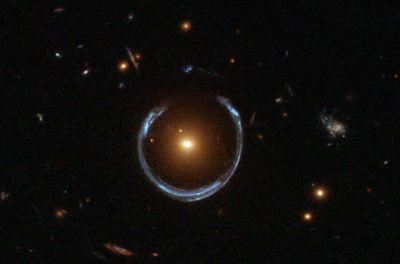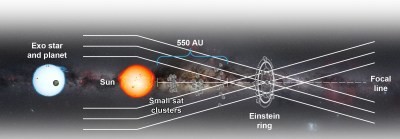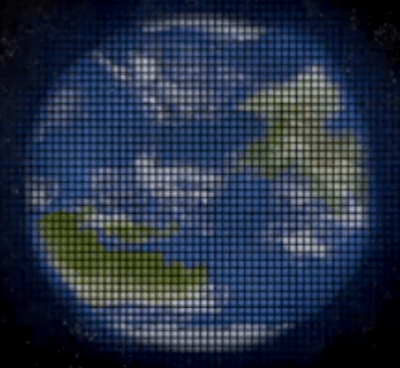Astronomy is undoubtedly one of the most exciting subjects in physics. Especially the search for exoplanets has been a thriving field in the last decades. While the first exoplanet was only discovered in 1992, there are now 4,144 confirmed exoplanets (as of 2nd April 2020). Naturally, we Sci-Fi lovers are most interested in the 55 potentially habitable exoplanets. Unfortunately, taking an image of an Earth 2.0 with enough detail to identify potential features of life is impossible with conventional telescopes.
The solar gravitational lens mission, which has recently been selected for phase III funding by the NASA Innovative Advanced Concepts (NIAC) program, is aiming to change that by taking advantage of the Sun’s gravitational lensing effect.
It all started with Einstein

Not surprisingly, it was Einstein who calculated in 1936 that the gravitational field of a star can act as a lens. If an object is located behind the star on the same line of sight as the observer, the resulting image will form a ring, nowadays known as an Einstein ring. It was not until 1979 that the effect was discovered when two suspiciously similar objects were observed turning out to be a double image formed by a gravitational lens. Today gravitational lensing is used to quantify the amount and distribution of dark matter. As hinted in the introduction, due to the brightness amplification caused by a gravitational lens it can also serve as a kind of gravitational telescope, allowing the detection of faint galaxies from the early Universe.
AI and Citizen Scientists help to find Needles in a Haystack
Gravitational lenses are quite rare and one typically has to look at a thousand different galaxy images to find one. In addition, recognizing and unwinding the distortion of a gravitational lens on an image is not a trivial task. Therefore, the space warps project relied on citizen scientists to identify gravitational lenses within data taken by the Hyper Suprime-Cam. (Astronomers pick epic-sounding names!) Machine learning algorithms can also be used to sift through the data of astronomical surveys. In particular, convolutional neural networks, which are also the basis for Facebook’s DeepFace facial recognition, have been used to identify gravitational lenses.
Using the Sun as a Lens

In contrast to an optical lens, a gravitational lens does not produce a single focal point but a focal line. As shown in the picture, the Solar Gravitational Lens (SGL) focusses incoming light to a line that starts at a distance of ~550 AU. If one would place a telescope at this point the SGL could magnify the brightness of a distant object by a factor of ~1011 and offers an angular resolution of ~10-10 arcsec. For an exo-Earth at 30 parsecs (~100 light-years) the SGL telescope could achieve ~25 km-scale surface resolution, enough to see surface features and signs of habitability.
A String-of-Pearls equipped with Solar Sails

The concept of the SGL mission is very well explained in the video embedded below. First of all, one of the biggest problems is getting to the Sun’s focus point. The most distant space probe Voyager 1 launched in 1977 is currently at 148 AU, i.e. at the same velocity, it would take >150 years to get to the nearest SGL focus point. Because of the required velocity and long operating life current chemical and nuclear propulsion techniques are inadequate. Instead, the SGL mission will use solar sails driven by the Sun’s radiation pressure. By flying closely around the Sun the SGL spacecraft could achieve a velocity of 25 AU/year, reaching the SGL focus region in <25 years total flight time.
Employing a single spacecraft would be impractical for the SGL mission because of the high risk of failure during the long flight. Instead, the mission concept follows a string-of-pearls approach where a pearl consists of 10 to 20 small spacecraft (smallsats) weighing <100 kg that fly in formation. The entire string will be formed by multiple pearls launched at ~1-year intervals. Having multiple smallsats allows for some redundancy thereby limiting the risk of single point failure. It also helps to spread the costs over time and among the participants. Otherwise, a mission of this magnitude will likely never be able to secure enough funding.
Each smallsat should operate mostly autonomously which becomes more important the further away it gets from Earth. The final SGL communication latency is around four days. To achieve autonomous navigation, data processing, and fault management the SGL mission counts on several emerging AI technologies and throws around a lot of buzzwords like Explainable AI, Lifelong Learning Machines, Learning with Less Labels, and Neuromorphic chip design.
Challenges also arise for the imaging instruments. A coronagraph, made of a phase mask that works through destructive interference, is being used to block out the direct light from our Sun. This still leaves the light from the Sun’s corona as background source, which will overlap with the Einstein ring. To reduce this overlap the telescope needs to be placed yet further away from the Sun at about 650 AU. Finally, the telescope will not be large enough to image the whole Einstein ring at once. The image of an Earth-sized exoplanet at 30 parsec is compressed by the SGL to a cylinder with a diameter of ~1.3 km in the immediate vicinity of the focal line. For a 1 m telescope to obtain a 1000 x 1000 pixel image, the spacecraft would have to scan this area one pixel at a time by moving in small steps of 1.3 m. The original image of the exoplanet is then reconstructed via a deconvolution algorithm.
When do we get there?
So when will we get the first high-resolution image of an exoplanet? Naturally, the timelines for science projects of this magnitude are very vague and can easily get shifted behind by 5-10 years. In the phase II summary report it is stated that the remaining technological development would allow launch in 2028-2030. Realistically, this means we could get first data somewhere around the early 2060s.
What planet will they look at? Since there will likely be several new potentially habitable planets discovered before the SGL mission will reach its destination, the target is not yet fixed. Currently, one the most promising candidates is TRAPPIST-1e, a rocky, almost Earth-sized planet located at 12.1 parsecs distance that may also contain liquid water. The planet will be more closely observed by the James Webb Space Telescope planned to launch next year.
What will they look for? Checking for signs of habitability will include spectroscopic investigation of the atmosphere to check for biomarkers such as oxygen and methane. It will also be possible to look for artificial light sources at night time as well as radio transmissions.
The Sun has not only enabled life on Earth but can also serve as a tool to search for life on other planets. It is quite exciting that the question “Are we alone in the Universe?” may be answered with a negative within our lifetime. This makes you wonder how many similar telescopes are already pointed at us.
















Somebody’s dreaming. We can’t even get the James Webb space telescope into space, what are the chances of this ever flying?
Even if it does fly, there is still the biggest issue that you need to move enormous distance to observe some **other** target (since the sun must stay in the direction, it means moving on a circle with a radius of 650AU). So if your initial bet on a exoplanet is not good enough, you’d have to wait 50 years or so to be in “focus” of another potential target.
In reality, such small sat are unable to come back to Earth, they’d only have to store enough mass to stop when reached their expected position (is that even possible ?). So that make the whole process an “extremely costly and too riskful oneshot experience to perform”.
think it would still work with a probe on a highly eccentric orbit, as space craft on such trajectories tend to linger at their aphelion for a long time. using the same probe to image another exoplanet would require having it come around again and do a small course correction and perihelion. it would make more sense just to send multiple parallel missions to different focal points.
I think that the satellites wouldn’t go into solar orbit. They get thrown _very hard_ straight away with the sun, then take images as they fly through the sweet spot.
If this is the case then the first cloud of satellites would image targets around star A, the second cloud could be launched on a different angle to image targets around star B, etc.
Costs would be quite high per target, but the performance is ridiculous.
Also note the video talks about 1m telescopes which are way easier to build and launch than the James Webb.
There’s also a “societal” element to this, presuming someone’s home.
What would we do in our current state of affairs if a string of unmanned spacecraft with fissile material (don’t forget the isotope thermoelectric generators to keep everything warm and powered) started showing up on our doorstep?
The thoughtful answer would be “Examine it to try and figure out who sent it and why”, but there’s a lot of thoughtlessness in the universe. Some of it is always local.
What? We would only be imaging TRAPPIST-1e, not sending the telescopes to it. The telescopes would be at 650 AU, still within our solar system and not even 1/50th of the way to the Oort Cloud. There’s nothing and nobody at 650 AU. TRAPPIST-1e is roughly 39.6 light-years or around 2,504,347 AU away. We’re not sending anything to anyone’s doorstep 39.6 light-years away.
Gravitational lensing was known well before 1936. The Eddington experiment in 1919 indicated that there would be a focal ring. See: https://en.wikipedia.org/wiki/Eddington_experiment
Astronomers recently redid this experiment during a recent eclipse with expected results. It is a very difficult and precise experiment with extremely tight measurements.
Mr. Crosby is corrected. Eddington detected deflection, with stars slightly out of position, NOT the double image lensing. The link provided does not support the contention that “The Eddington experiment in 1919 indicated that there would be a focal ring.”
“Gravitational lenses are quite rare” No. They are not rare at all. Every sufficiently massive body has one. It’s detecting them that is rare.
I guess the prepending of the word useful would have been helpful, handy, of utility, convenient, here, or profitable, efficacious, damn what’s the exact word I’m looking for to describe how fruitful that would have been?
” (Astronomers pick epic-sounding names!) ”
But, I’m guessing NASA will never name another satellite that rhymes with “trouble”.
B^)
Using Sun is a bit unrealistic at the moment. But check out this idea – using Earth’s atmosphere light bending instead of Sun’s gravitiational effect: https://www.youtube.com/watch?v=jgOTZe07eHA
I was thinking about posting this exact video, you beat me to it. The whole time I read the article I was thinking this is rediclous why would anyone put money in to a project like this whithout using the earth’s lensing effects first. It could be completed much quicker and the risks are far less to equiptment involved.
“why would anyone put money in to a project like this”
This is a NIAC proposal. NIAC is basically high-risk, high reward long term development. NIAC doesn’t really fund experiments (in the ‘build a satellite’ sense), it funds research that can *lead* to them.
The Terrascope idea is a totally different use-case.
They’re not talking about using gravity, which would provide a pretty clean image, but instead talking about using the Earth’s atmosphere (like you said) to increase collecting area. The problem with this is that the *resolution* would be limited by seeing (how stable the atmosphere is) just like Earth-based telescopes are, and for a Terrascope the seeing would be dramatically worse (more atmosphere). The paper estimated it as tens of arcseconds, which is ludicrously awful. In other words, the Terrascope would barely be able to resolve *Jupiter*. It would still be useful, though, because of the massive increase in *sensitivity* (still not as large as the SGL idea, obviously, but substantial).
To actually image exoplanets you need to get down to nano-arcsecond resolution, which the Terrascope definitely wouldn’t provide.
According to https://www.centauri-dreams.org/2016/04/26/gravitational-lensing-with-planets/ the gravitational lens focal lengths of the Earth is 15,375 AU. That’s even greater than the Sun’s focal length by a substantial margin. On the other hand, the Earth doesn’t radiate as egregiously as the sun. Your interesting link posits an outer-atmospheric telescope with a focal length of about 4 Earth-Moon distances. The author mentions a few likely problems, to which I’d add chromatic aberration and poor resolution. Time will tell if it’s a good thing to try.
Thanks.
just out of curiousity, I think I’ve seen many announcements of solar sail projects, trials, etc. Have any actually been successful? Seems like a key technology.
Mariner 10 (1973) used solar radiation pressure on its panels for attitude control during its passes of Mercury. IKAROS (2010) demonstrated acceleration and attitude control with solar sails on its trip to Venus.
my sci-fi book “550AU Buried in Stone” [http://www.amazon.com/dp/B07QXPTY86] outlines the pros and challenges. Anyone know of any other fiction featuring a solar grav lensing telescope?